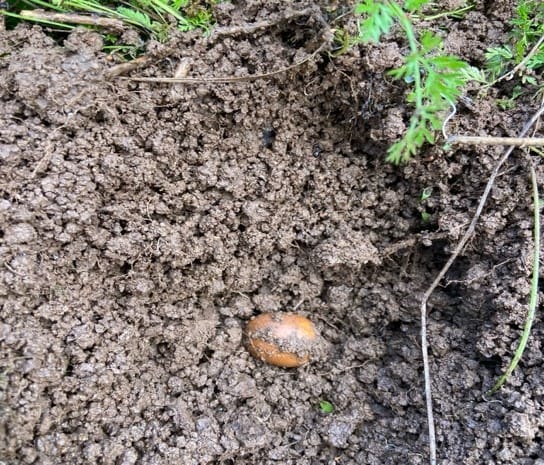The Planting of an Oak

(Note: This is a first that I hope will oft be repeated. My friend graciously and enthusiastically accepted my invitation to share thoughts and feelings about why the planting of oaks and helping with the reestablishment of an oak forest is important and meaningful to her.)
By Katharine Cahn, Guest Contributor
It’s a soggy fall day in the Oregon coast range. I pick my way carefully down a hill, once a farmer’s field, and I’m glad for good rain gear. Sodden mounds of grass bounce back under my rubber boots, the ground squishing with every step. An occasional sunbreak reveals gold across the valley, but my task is nearer to hand.
My assignment starts with finding a patch of ground free of gopher holes and stickers. There, I clear off wet grass and dig three muddy holes close together and about 8 inches deep. Into each hole I place a perfect golden acorn. Then, I gently brush over each one a blanket of protective rich wet soil, and tamp it down securely. Once each acorn is planted, I place over it a net covering and a pole marked with red ribbon. These will serve as both marker and protection in the months to come. I imagine each little acorn settling in, sending roots down and shoots up seeking the warm spring sun when the time comes.
Foresters Peter and Pam who own this field tell me there is an oak in the Tualatin Valley, originally one of a grove of five, documented to be at least 600 years old. Some of the acorns we will plant today are from that ancient oak, though mine are not. To reach maturity an acorn must survive the threat of being eaten by elk or gopher, crowded out by a bigger or shadier plant, or succumbing to some killer bug or virus we can’t anticipate. Who knows which of these acorns we plant today will succeed? It will take a lot of luck to become a stately 600-year oak, or even reach 100 years.
But what a thing to contemplate, that this little golden acorn I plant today, this precious one I hold in the palm of my muddy glove, one of hundreds our group will plant up and down this hill today, might reach such an age.
Recently retired as an advocate and educator, I dared to hope that some of my work might help families in the future. But to be honest, many of our efforts will fade away. Today, I’m struck by the possibility that this humble acorn, now resting in the dark brown soil, awaiting the warmth of spring, might offer shelter to a being – human or animal or bird – so far in the future. Maybe planting an acorn is like a prayer.
Either way, just now, I’m completely happy and muddy and grateful. This moment is good.
